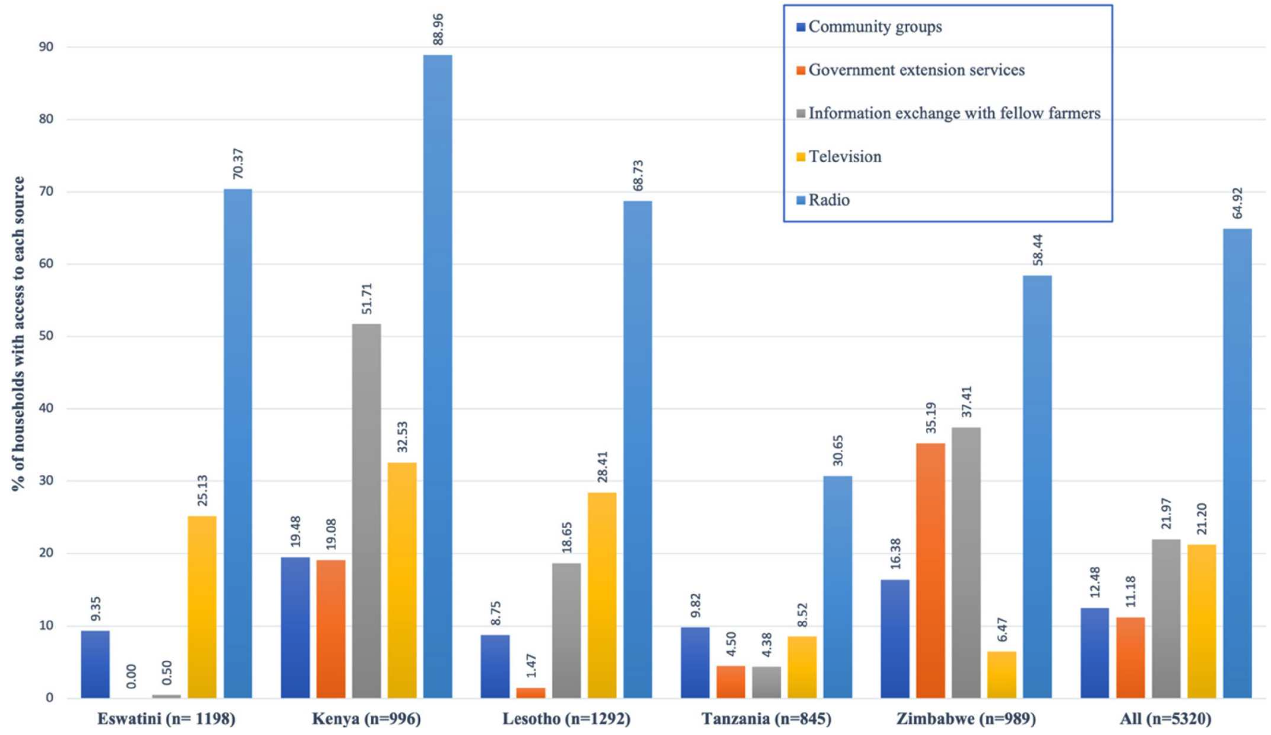Climate information access and use in East and Southern Africa: identifying linkages between smallholder household characteristics and climate change adaptation
Authors: Minjauw, F. Rasheduzzaman, M., Huang, J., Lozano, A., Baumgartner, P., Doward, P., Clarkson, G., & Cohen, A.*
Publication Year: 2024 | Journal / Publisher: Climate and Development
Abstract/Summary: Climate change adversely impacts the livelihoods of smallholder farmers across East and Southern Africa. Climate-related information is assumed to support smallholder farmer decision-making and use of adaptive practices as a means to improve livelihoods, resiliency and levels of food security. However, the value of climate information provision and its role in promoting adaptive practices remains poorly understood. We examined smallholder household access to, and use of, climate information. Survey data was collected from 5322 households across Eswatini, Kenya, Lesotho, Tanzania and Zimbabwe using the Multidimensional Poverty Assessment Tool. Overall, the majority of households regularly accessed at least one source of climate information, primarily via radio (64.9%, n = 3453). Our statistical models showed that households with relatively better access to credit and land tenure were more likely to receive climate information (p < 0.01 and p < 0.001, respectively, n = 1421), and of those, households who reported observing past climate-related changes were more likely to actually use climate information (p < 0.05, n = 1097). Secure land tenure was positively associated with information use, though not statistically significant. Findings from our study offer guidance for improving the targeting and delivery of climate information programmes and policies, and indicate that the assumed benefits of climate information provision should be more rigorously evaluated.
PDF on Publisher Website | PDF on OSF
Perceptions of poverty: Evaluating Multidimensional Poverty Assessment Tool derived rankings and global development indicators in five African nations
Authors: Minjauw, F., Rasheduzzaman, M., Baumgartner, P., Doward, P., Clarkson, G., & Cohen, A.*
Publication Year: 2024 | Journal / Publisher: Journal of International Development
Abstract/Summary: This study assessed an array of indicators for rural poverty assessments and evaluated use of the Multidimensional Poverty Assessment Tool (MPAT) as a proxy for commonly used indicators, such as the Human Development Index, Gross National Income, Global Hunger Index, and the Gender Inequality Index. MPAT data from 5322 rural households across five countries in Africa were analyzed. While MPAT aligned well with development indicators for Kenya, Lesotho, and Tanzania, this was not the case for Eswatini and Zimbabwe. Overall, MPAT-based rankings correlated well with hunger, food security, and gender equality indicators. Our findings highlight the use of MPAT-derived indices as valuable supplements for commonly used development indicators.
PDF on Publisher Website | PDF on OSF
The Human Right to Water: A 20-Year Comparative Analysis of Arsenic in Rural and Carceral Drinking Water Systems in California
Authors: Rempel, J., Ray, I., Hessl, E., Vazin, J., Zhou, Z., Kim, S., Zhang, X., Ding, C., He, Z., Pellow, D., & Cohen, A.
Publication Year: 2022 | Journal / Publisher: Environmental Health Perspectives
Abstract/Summary: Access to safe drinking water is considered a universal human right. In the U.S., exposure to arsenic contamination in drinking water disproportionately impacts small, groundwater-reliant communities and communities of color. Limited research exists on water quality in prisons; however, prisons in the Southwestern U.S. have elevated arsenic concentrations compared to other community water systems (CWS) in the region. In this paper we present a comparative analysis of 20 years of data (2001-2021) on arsenic concentrations in the CWSs serving Kern Valley State Prison (KVSP) and three neighboring rural communities: Allensworth, Delano, and McFarland. Our objective was to better understand trends in water quality, compliance, and treatment following adoption of the revised arsenic MCL, and to elucidate differences, if any, between neighboring incarcerated and non-incarcerated populations.
PDF on Publisher Website | PDF on OSF
The impacts of socioeconomic development on rural drinking water safety in China: A provincial-level comparative analysis
Authors: Li, H., Cohen, A., Li, Z., & Zhang, M.
Publication Year: 2019 | Journal / Publisher: Sustainability
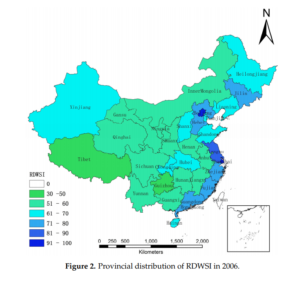 Abstract/Summary:In China, achieving rural drinking water safety—meaning access to a safe, affordable, sufficient, and sustainable drinking water supply—remains a key challenge for government agencies and researchers. Using cross-sectional data at the provincial level, in this paper we examine the impacts of socioeconomic development on drinking water safety in rural China. Using a theoretical framework called Pressure-State-Response (PSR), existing data were organized into state and pressure indicators. Canonical Correlation Analysis was then used to analyze provincial-level relationships between the indicators. Significant drinking-water-safety-related differences were found across provinces. Our analyses suggest that, overall, China’s recent and rapid socioeconomic development yielded substantial benefits for China’s rural drinking water safety. However, this same development also negatively impacted rural drinking water safety via increased groundwater over-abstraction, reductions in water supply, and environmental contamination. The paper closes with a discussion of implications and options for improving drinking water policy, management, and regulation in rural China.
Abstract/Summary:In China, achieving rural drinking water safety—meaning access to a safe, affordable, sufficient, and sustainable drinking water supply—remains a key challenge for government agencies and researchers. Using cross-sectional data at the provincial level, in this paper we examine the impacts of socioeconomic development on drinking water safety in rural China. Using a theoretical framework called Pressure-State-Response (PSR), existing data were organized into state and pressure indicators. Canonical Correlation Analysis was then used to analyze provincial-level relationships between the indicators. Significant drinking-water-safety-related differences were found across provinces. Our analyses suggest that, overall, China’s recent and rapid socioeconomic development yielded substantial benefits for China’s rural drinking water safety. However, this same development also negatively impacted rural drinking water safety via increased groundwater over-abstraction, reductions in water supply, and environmental contamination. The paper closes with a discussion of implications and options for improving drinking water policy, management, and regulation in rural China.
PDF on Publisher Website | PDF on OSF
Fuel use trends for boiling water in rural China (1992-2012) & environmental health implications: A national cross-sectional study
Authors: Du, W., Cohen, A., Shen, G., Ru, M., Shen, H., & Shu, T.
Publication Year: 2018 | Journal / Publisher: Environmental Science & Technology
 Abstract/Summary:Survey data from a comprehensive national survey of ∼34 000 households were analyzed for the mix status and transition trajectory of energy for boiling water in rural Chinese households from 1992 to 2012. In 1992, ∼6% of households reported using electricity, biogas, or liquefied petroleum gas (LPG) to boil drinking water; in 2012, the proportion was ∼60%. Income per capita appeared most strongly associated with this transition toward electricity and other clean fuels. Median annual incomes for households using biomass fuels, electric kettles, and LPG were RMB 15 000, 28 000, and 30 000, respectively. Overall, the transition was most pronounced in eastern China, a region which experienced relatively higher rates of economic growth over the same 20-year period. Energy type preferences appear to be highly dependent on fuel accessibility such that coal and straw usage was higher in provinces with higher coal and grain production. These trends suggest that electric kettle use would likely increase from ∼29% (2012) to ∼60% by 2030, at which point <5% of rural households would be expected to boil with solid fuels. Recent evidence suggests that this transition could contribute to reductions in water-related gastrointestinal illness as well as reductions in air pollutant emissions in rural China.
Abstract/Summary:Survey data from a comprehensive national survey of ∼34 000 households were analyzed for the mix status and transition trajectory of energy for boiling water in rural Chinese households from 1992 to 2012. In 1992, ∼6% of households reported using electricity, biogas, or liquefied petroleum gas (LPG) to boil drinking water; in 2012, the proportion was ∼60%. Income per capita appeared most strongly associated with this transition toward electricity and other clean fuels. Median annual incomes for households using biomass fuels, electric kettles, and LPG were RMB 15 000, 28 000, and 30 000, respectively. Overall, the transition was most pronounced in eastern China, a region which experienced relatively higher rates of economic growth over the same 20-year period. Energy type preferences appear to be highly dependent on fuel accessibility such that coal and straw usage was higher in provinces with higher coal and grain production. These trends suggest that electric kettle use would likely increase from ∼29% (2012) to ∼60% by 2030, at which point <5% of rural households would be expected to boil with solid fuels. Recent evidence suggests that this transition could contribute to reductions in water-related gastrointestinal illness as well as reductions in air pollutant emissions in rural China.
PDF on Publisher Website | PDF on OSF
The global risks of increasing reliance on bottled water
Authors: Alasdair Cohen and Isha Ray
Publication Year: 2018 | Journal / Publisher: Nature Sustainability
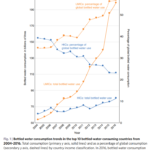 Abstract/Summary: The rapid growth of bottled water use in low- and middle-income countries, and its normalization as a daily source of drinking water, does not provide a pathway to universal access. Generous and sustained investment in centralized and community utilities remains the most viable means for achieving safe water access for all. We recommend that the international development community and LMIC governments accept that full-cost recovery from a low-income customer base is not realistic, and that they actively invest in regulated utilities or community-scale models as the most sustainable options for delivering universal safe water access. This will take time, of course. Consumer confidence in the safety of utility supplied water should be fortified along the way with water quality reports and, perhaps, ‘marketing’ messages. These recommendations are not new, but they bear repeating in an era of explosive growth in, and de facto normalization of, market-driven approaches to ‘safe water for all’. In the meantime, non-tap treatment options that are known to be effective and affordable, but that may achieve only partial uptake, should be subsidized and more aggressively promoted. If, on the other hand, governments and development agencies allow the bottled water sector to continue meeting the rising demand for safe water in LMICs, then access will indeed expand by 2030, but it will not be reliably safe or universally affordable. The SDG for drinking water is a public commitment, and history is clear: public commitments need public investment.
Abstract/Summary: The rapid growth of bottled water use in low- and middle-income countries, and its normalization as a daily source of drinking water, does not provide a pathway to universal access. Generous and sustained investment in centralized and community utilities remains the most viable means for achieving safe water access for all. We recommend that the international development community and LMIC governments accept that full-cost recovery from a low-income customer base is not realistic, and that they actively invest in regulated utilities or community-scale models as the most sustainable options for delivering universal safe water access. This will take time, of course. Consumer confidence in the safety of utility supplied water should be fortified along the way with water quality reports and, perhaps, ‘marketing’ messages. These recommendations are not new, but they bear repeating in an era of explosive growth in, and de facto normalization of, market-driven approaches to ‘safe water for all’. In the meantime, non-tap treatment options that are known to be effective and affordable, but that may achieve only partial uptake, should be subsidized and more aggressively promoted. If, on the other hand, governments and development agencies allow the bottled water sector to continue meeting the rising demand for safe water in LMICs, then access will indeed expand by 2030, but it will not be reliably safe or universally affordable. The SDG for drinking water is a public commitment, and history is clear: public commitments need public investment.
PDF on Publisher Website | PDF on OSF
Effects of boiling drinking water on diarrhea & pathogen-specific infections in low- & middle-income countries: A systematic review & meta-analysis
Authors: Cohen, A. & Colford, J. M.
Publication Year: 2017 | Journal / Publisher: American Journal of Tropical Medicine & Hygiene
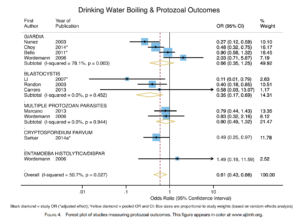 Abstract/Summary: Globally, approximately 2 billion people lack microbiologically safe drinking water. Boiling is the most prevalent household water treatment method, yet evidence of its health impact is limited. To conduct this systematic review, we searched four online databases with no limitations on language or publication date. Studies were eligible if health outcomes were measured for participants who reported consuming boiled and untreated water. We used reported and calculated odds ratios (ORs) and random-effects meta-analysis to estimate pathogen-specific and pooled effects by organism group and nonspecific diarrhea. Heterogeneity and publication bias were assessed using I2, meta-regression, and funnel plots; study quality was also assessed. Of the 1,998 records identified, 27 met inclusion criteria and reported extractable data. We found evidence of a significant protective effect of boiling for Vibrio cholerae infections (OR = 0.31, 95% confidence interval [CI] = 0.13–0.79, N = 4 studies), Blastocystis (OR = 0.35, 95% CI = 0.17–0.69, N = 3), protozoal infections overall (pooled OR = 0.61, 95% CI = 0.43–0.86, N = 11), viral infections overall (pooled OR = 0.83, 95% CI =0.7–0.98, N = 4), and nonspecific diarrheal outcomes (OR = 0.58, 95% CI = 0.45–0.77, N = 7). We found no evidence of a protective effect for helminthic infections. Although our study was limited by the use of self-reported boiling and non-experimental designs, the evidence suggests that boiling provides measurable health benefits for pathogens whose transmission routes are primarily water based. Consequently, we believe a randomized controlled trial of boiling adherence and health outcomes is needed.
Abstract/Summary: Globally, approximately 2 billion people lack microbiologically safe drinking water. Boiling is the most prevalent household water treatment method, yet evidence of its health impact is limited. To conduct this systematic review, we searched four online databases with no limitations on language or publication date. Studies were eligible if health outcomes were measured for participants who reported consuming boiled and untreated water. We used reported and calculated odds ratios (ORs) and random-effects meta-analysis to estimate pathogen-specific and pooled effects by organism group and nonspecific diarrhea. Heterogeneity and publication bias were assessed using I2, meta-regression, and funnel plots; study quality was also assessed. Of the 1,998 records identified, 27 met inclusion criteria and reported extractable data. We found evidence of a significant protective effect of boiling for Vibrio cholerae infections (OR = 0.31, 95% confidence interval [CI] = 0.13–0.79, N = 4 studies), Blastocystis (OR = 0.35, 95% CI = 0.17–0.69, N = 3), protozoal infections overall (pooled OR = 0.61, 95% CI = 0.43–0.86, N = 11), viral infections overall (pooled OR = 0.83, 95% CI =0.7–0.98, N = 4), and nonspecific diarrheal outcomes (OR = 0.58, 95% CI = 0.45–0.77, N = 7). We found no evidence of a protective effect for helminthic infections. Although our study was limited by the use of self-reported boiling and non-experimental designs, the evidence suggests that boiling provides measurable health benefits for pathogens whose transmission routes are primarily water based. Consequently, we believe a randomized controlled trial of boiling adherence and health outcomes is needed.
PDF on Publisher Website | PDF on OSF
Quantifying the qualitative: Eliciting expert input to develop the Multidimensional Poverty Assessment Tool
Authors: Cohen, A. & Saisana, M.
Publication Year: 2014 | Journal / Publisher: Journal of Development Studies
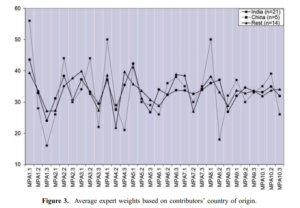 Abstract/Summary: This article discusses the participatory creation of the Multidimensional Poverty Assessment Tool (MPAT), a survey-based thematic indicator developed in China and India. The core of the article focuses on the use of expert elicitation to inform the construction of MPAT’s household and village surveys, the cardinalisation of survey responses, and the weighting scheme design. This is followed by a discussion of the potential pitfalls of expertise in development, the decision not to aggregate MPAT into an index, creating locally relevant poverty lines, and ideas for future research. The article closes with a summary of lessons learned.
Abstract/Summary: This article discusses the participatory creation of the Multidimensional Poverty Assessment Tool (MPAT), a survey-based thematic indicator developed in China and India. The core of the article focuses on the use of expert elicitation to inform the construction of MPAT’s household and village surveys, the cardinalisation of survey responses, and the weighting scheme design. This is followed by a discussion of the potential pitfalls of expertise in development, the decision not to aggregate MPAT into an index, creating locally relevant poverty lines, and ideas for future research. The article closes with a summary of lessons learned.
PDF on Publisher Website | PDF on OSF
The Multidimensional Poverty Assessment Tool: Brochure (& Infographics)
Authors: IFAD [Cohen, A.]
Publication Year: 2014 | Journal / Publisher: United Nations International Fund for Agricultural Development
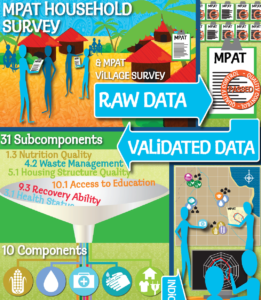 Abstract/Summary: The Multidimensional Poverty Assessment Tool (MPAT) provides data that can inform all levels of decision making by providing a clearer understanding of rural poverty at the household and village level. As a result, MPAT can significantly strengthen the planning, design, monitoring and evaluation of a project, and thereby contribute to rural poverty reduction.
Abstract/Summary: The Multidimensional Poverty Assessment Tool (MPAT) provides data that can inform all levels of decision making by providing a clearer understanding of rural poverty at the household and village level. As a result, MPAT can significantly strengthen the planning, design, monitoring and evaluation of a project, and thereby contribute to rural poverty reduction.
This brochure explains:
-
- What MPAT is
- How MPAT works
- When to use MPAT and why
- How to use MPAT
- What resources are available for implementing MPAT
The tool allows project managers, government officials, researchers and others to identify and monitor sectors that require support in order to reduce rural poverty and improve livelihoods. It also provides an objective means of justifying resource allocation or planning priorities. MPAT is based on a bottom-up, participatory approach that reflects communities’ voices, wants and perspectives.
PDF on Publisher Website | PDF on OSF
The Multidimensional Poverty Assessment Tool: User’s Guide
Authors: IFAD [Cohen, A. & Jayne, S.]
Publication Year: 2014 | Journal / Publisher: United Nations International Fund for Agricultural Development
 Abstract/Summary: The Multidimensional Poverty Assessment Tool (MPAT) provides a method for simplifying the complexity of rural poverty in order to support poverty alleviation efforts. MPAT uses thoroughly designed and tested purpose-built surveys to collect data on people’s perceptions about fundamental and interconnected aspects of their lives, livelihoods and environments. Standardized indicators, developed through a comprehensive participatory process, are then employed to combine, distil and present these data in an accessible way. MPAT was developed through a participatory, collaborative process based on expert feedback from dozens of international development experts from IFAD, other United Nations agencies, international and regional organizations, and universities from around the world. It was field-tested in countries in both Asia and Africa. In the pages that follow, we explain what MPAT is, how it works and how it is used, providing step-by-step instructions, training materials and other resources. The ultimate objective of this User’s Guide and the accompanying Excel Spreadsheet is to make MPAT a truly free and open-source tool, so that any institution or agency, big or small, may implement MPAT on its own.
Abstract/Summary: The Multidimensional Poverty Assessment Tool (MPAT) provides a method for simplifying the complexity of rural poverty in order to support poverty alleviation efforts. MPAT uses thoroughly designed and tested purpose-built surveys to collect data on people’s perceptions about fundamental and interconnected aspects of their lives, livelihoods and environments. Standardized indicators, developed through a comprehensive participatory process, are then employed to combine, distil and present these data in an accessible way. MPAT was developed through a participatory, collaborative process based on expert feedback from dozens of international development experts from IFAD, other United Nations agencies, international and regional organizations, and universities from around the world. It was field-tested in countries in both Asia and Africa. In the pages that follow, we explain what MPAT is, how it works and how it is used, providing step-by-step instructions, training materials and other resources. The ultimate objective of this User’s Guide and the accompanying Excel Spreadsheet is to make MPAT a truly free and open-source tool, so that any institution or agency, big or small, may implement MPAT on its own.
PDF on Publisher Website | PDF on OSF
The Multidimensional Poverty Assessment Tool: A new framework for measuring rural poverty.
Authors: Cohen, A.
Publication Year: 2010 | Journal / Publisher: Development in Practice
 The Multidimensional Poverty Assessment Tool (MPAT) measures fundamental dimensions of rural poverty in order to support poverty-alleviation efforts in the less developed world. This article’s primary purpose is to introduce MPAT and describe its theoretical rationale. It begins with an overview of the importance of creating enabling environments for rural poverty alleviation before describing MPAT’s purpose and structure. The article goes on to address some of the advantages and shortcomings of surveys and indicators as means of measuring poverty, and concludes with a few caveats on using MPAT, and a focus on its added value to practitioners and academics.
The Multidimensional Poverty Assessment Tool (MPAT) measures fundamental dimensions of rural poverty in order to support poverty-alleviation efforts in the less developed world. This article’s primary purpose is to introduce MPAT and describe its theoretical rationale. It begins with an overview of the importance of creating enabling environments for rural poverty alleviation before describing MPAT’s purpose and structure. The article goes on to address some of the advantages and shortcomings of surveys and indicators as means of measuring poverty, and concludes with a few caveats on using MPAT, and a focus on its added value to practitioners and academics.
PDF on Publisher Website | PDF on OSF
Water & poverty in rural China: Developing an instrument to assess the multiple dimensions of water & poverty
Authors: Cohen, A. & Sullivan, C.
Publication Year: 2010 | Journal / Publisher: Ecological Economics
 Abstract/Summary: This paper describes the theoretical foundations and development of a multidimensional, water-focused, thematic indicator of rural poverty: The Water, Economy, Investment and Learning Assessment Indicator (WEILAI). The WEILAI approach was specifically designed for application in rural China, to support poverty alleviation project planning, monitoring and evaluation, as well as targeting and prioritization. WEILAI builds primarily on the basic needs framework of poverty alleviation, and on the methodological structure of the Water Poverty Index, to provide a proxy measure of an area’s poverty by assessing eight key poverty sectors, with a strong focus on the components of water-poverty. The WEILAI approach was piloted and implemented in 534 households in China’s mountainous southwest. This paper describes the indicator construction, weighting schemes, methodology, field sites, and statistical validation of the results. In addition, we discuss the results, feedback from in-country project staff, and the likely utility of the tool for project planning, monitoring and evaluation support. The paper concludes with a discussion of WEILAI’s overall utility and ongoing development.
Abstract/Summary: This paper describes the theoretical foundations and development of a multidimensional, water-focused, thematic indicator of rural poverty: The Water, Economy, Investment and Learning Assessment Indicator (WEILAI). The WEILAI approach was specifically designed for application in rural China, to support poverty alleviation project planning, monitoring and evaluation, as well as targeting and prioritization. WEILAI builds primarily on the basic needs framework of poverty alleviation, and on the methodological structure of the Water Poverty Index, to provide a proxy measure of an area’s poverty by assessing eight key poverty sectors, with a strong focus on the components of water-poverty. The WEILAI approach was piloted and implemented in 534 households in China’s mountainous southwest. This paper describes the indicator construction, weighting schemes, methodology, field sites, and statistical validation of the results. In addition, we discuss the results, feedback from in-country project staff, and the likely utility of the tool for project planning, monitoring and evaluation support. The paper concludes with a discussion of WEILAI’s overall utility and ongoing development.
PDF on Publisher Website | PDF on OSF
The Multidimensional Poverty Assessment Tool: Design, development & application of a new framework for measuring rural poverty
Authors: Cohen, A.
Publication Year: 2009 | Journal / Publisher: United Nations International Fund for Agricultural Development
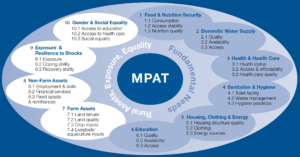 Abstract/Summary: The purpose of this book is to describe the theoretical foundations upon which the Multidimensional Poverty Assessment Tool (MPAT) was built, to tell the story of how it was created, developed, tested and piloted in rural China and India, and to explain how MPAT can be used to benefit rural communities around the world. Lasting poverty alleviation is achieved by fostering a comprehensive enabling environment within which people have a sufficiently high level of well-being and are able to pursue their livelihood goals based on their aspirations and initiative. To ensure that such environments are in place requires, at a minimum, an understanding of the key constraints rural people face – the fundamental dimensions central to their lives and livelihoods. MPAT does not try to define rural poverty per se; rather it takes a step back from assessment modalities that are overly focused on economic- and consumption-oriented indicators and strives to provide an overview of fundamental and relatively universal dimensions germane to rural livelihoods, rural life, and thus to rural poverty. By summarizing rural communities’ perceptions about key dimensions of rural poverty and focusing them through a quantitative lens, MPAT transparently illuminates problem areas so that all stakeholders can see where deficiencies lie and can begin to discuss which interventions may be most appropriate to address them, based on the local context.
Abstract/Summary: The purpose of this book is to describe the theoretical foundations upon which the Multidimensional Poverty Assessment Tool (MPAT) was built, to tell the story of how it was created, developed, tested and piloted in rural China and India, and to explain how MPAT can be used to benefit rural communities around the world. Lasting poverty alleviation is achieved by fostering a comprehensive enabling environment within which people have a sufficiently high level of well-being and are able to pursue their livelihood goals based on their aspirations and initiative. To ensure that such environments are in place requires, at a minimum, an understanding of the key constraints rural people face – the fundamental dimensions central to their lives and livelihoods. MPAT does not try to define rural poverty per se; rather it takes a step back from assessment modalities that are overly focused on economic- and consumption-oriented indicators and strives to provide an overview of fundamental and relatively universal dimensions germane to rural livelihoods, rural life, and thus to rural poverty. By summarizing rural communities’ perceptions about key dimensions of rural poverty and focusing them through a quantitative lens, MPAT transparently illuminates problem areas so that all stakeholders can see where deficiencies lie and can begin to discuss which interventions may be most appropriate to address them, based on the local context.
PDF on Publisher Website | PDF on OSF
The Rural Water Livelihoods Index. Working Paper
Authors: Sullivan, C., Cohen, A., Faurès, J. M., & Santini, G.
Publication Year: 2008 | Journal / Publisher: Food & Agriculture Organization of the United Nations
 Abstract/Summary: The Rural Water Livelihood Index (RWLI) is calculated on the basis of components and indicator values representing each of these four dimensions. The resulting composite index reflects the values for these four dimensions, and on this basis, judgements can be made on how water management might be improved. Each of the four dimensions (components) of the RWLI are represented by two subcomponents, which are combined using a weighted average. In this report, this framework is applied at the national scale, but the approach can be used at any scale as long as appropriate data is available. The purpose of the RWLI is to provide policy makers and planners at the national level an overview of where their country stands relative to others (much like the Human Development Index), and relative to themselves over time, to examine and monitor progress being made as a result of actions taken. This in turn will hopefully allow for better targeted water related interventions to improve rural livelihoods. Through the measurement of these key components, it will be possible to assess which of the four dimensions are most likely to benefit from interventions. Appropriate interventions are context-specific and will have to be identified on a country-by-country basis since contexts differ so widely (i.e., responses to address the reported states will be country and site-specific). However, a general Response Matrix is being developed to provide planners and policy makers a conceptual framework to guide this process and at a macro-level the index values help national-level planners identify which sectors might be most in need of assistance.
Abstract/Summary: The Rural Water Livelihood Index (RWLI) is calculated on the basis of components and indicator values representing each of these four dimensions. The resulting composite index reflects the values for these four dimensions, and on this basis, judgements can be made on how water management might be improved. Each of the four dimensions (components) of the RWLI are represented by two subcomponents, which are combined using a weighted average. In this report, this framework is applied at the national scale, but the approach can be used at any scale as long as appropriate data is available. The purpose of the RWLI is to provide policy makers and planners at the national level an overview of where their country stands relative to others (much like the Human Development Index), and relative to themselves over time, to examine and monitor progress being made as a result of actions taken. This in turn will hopefully allow for better targeted water related interventions to improve rural livelihoods. Through the measurement of these key components, it will be possible to assess which of the four dimensions are most likely to benefit from interventions. Appropriate interventions are context-specific and will have to be identified on a country-by-country basis since contexts differ so widely (i.e., responses to address the reported states will be country and site-specific). However, a general Response Matrix is being developed to provide planners and policy makers a conceptual framework to guide this process and at a macro-level the index values help national-level planners identify which sectors might be most in need of assistance.
PDF on Publisher Website | PDF on OSF

